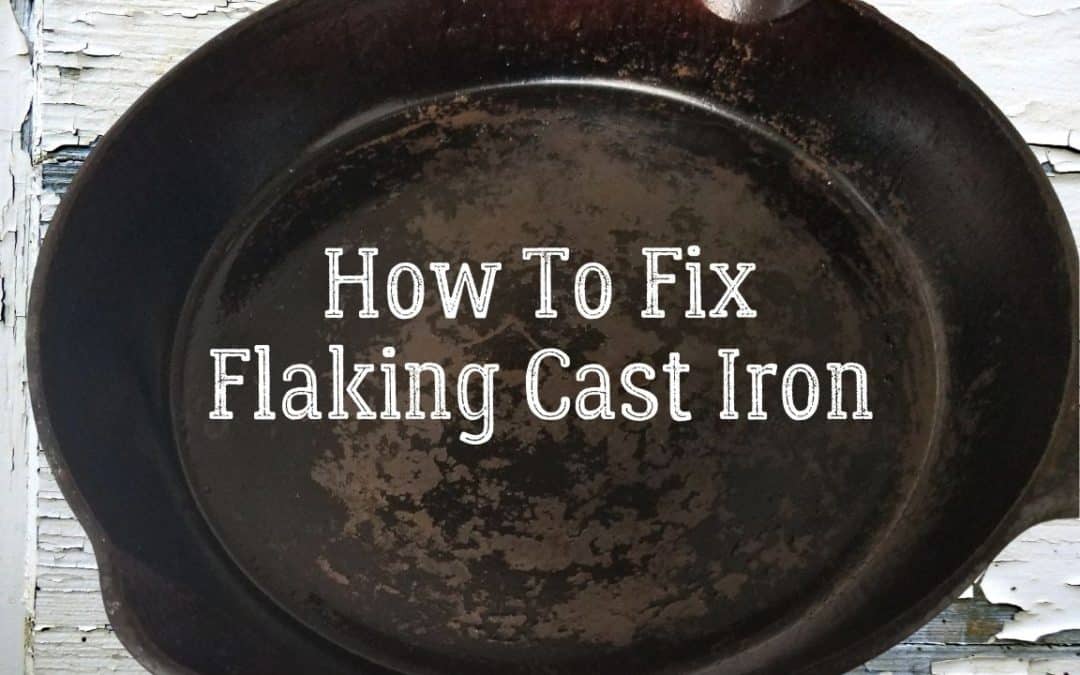“Why is my cast iron skillet flaking? Is it ruined?” I get this question frequently from people who are new to cast iron use and care. While it’s concerning to see small, black flakes peeling off of your skillet, it doesn’t mean your pan is ruined. In fact, cast iron flaking is a common problem with an easy fix.
Cast iron skillet flaking can be caused by: 1. The thin, factory pre-seasoning layer coming off during initial cooking or cleaning. 2. Additional seasoning layers not properly bonding with the iron. 3. Cooking acidic foods in an under-seasoned pan. 4. Scratching the pan with metal utensils.
What Are The Black Flakes Coming Off Of My Cast Iron Pan?
The black flakes peeling off a cast iron pan are typically bits of seasoning that didn’t properly bond with the iron. These flakes are made of carbonized oils or fats. While the flakes are not dangerous, it’s best to thoroughly scrub or strip the pan and re-season it two to three times to prevent further peeling.
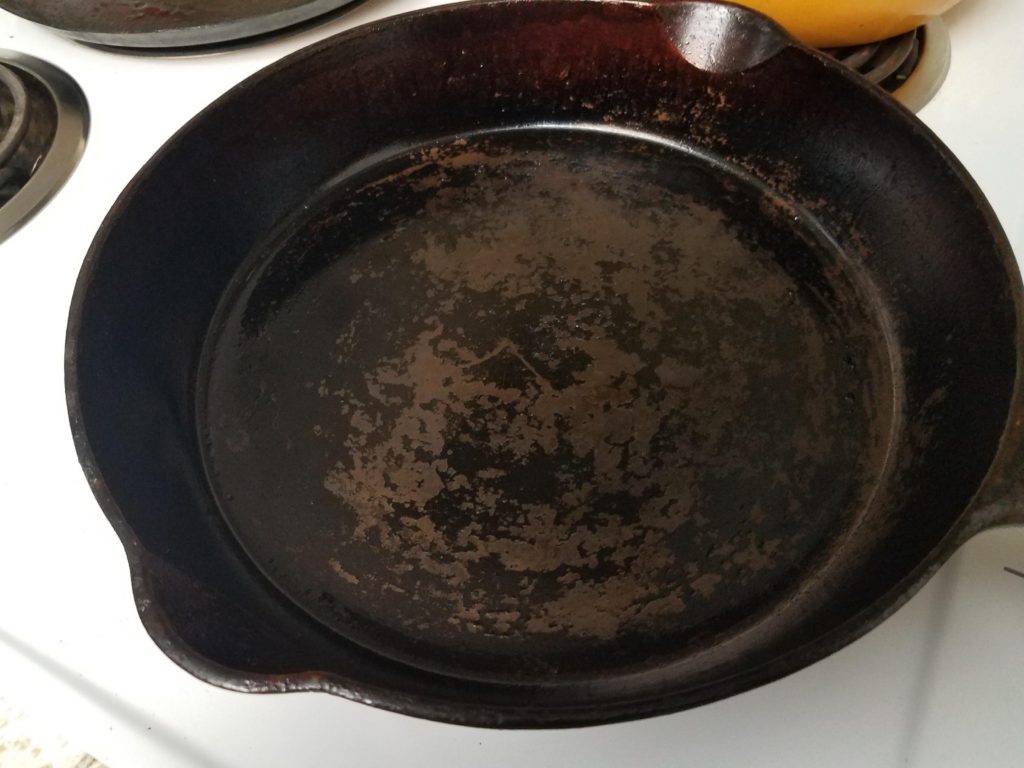
What Is Seasoning And Why Is It Important?
Cast iron seasoning is essentially multiple thin layers of oil baked onto the surface of the pan. This is done at a high temperature, which causes the liquid oil to bond with the iron on a molecular level and transform into a slick, hard surface through a process called polymerization. This creates the smooth, easy-release finish you want on a cast iron pan.
A strong seasoning layer is a cast iron pan’s best defense against flaking or peeling. To achieve a good seasoning layer, it’s important to use a high-quality oil such as grapeseed or canola oil, or an oil and wax blend like BuzzyWaxx.
The key to successfully seasoning cast iron is the application of multiple very thin layers of seasoning. Resist the urge to slather on a thick coating of oil in an attempt to fully season your pan in a single pass. Using too much oil always results in a sticky, goopy mess that’s guaranteed to peel off. Proper cast iron seasoning takes three to four rounds of oiling and heating.
For everything you need to know about seasoning, check out my helpful article, Seasoning Cast Iron Cookware: A Step-By-Step Guide.
Why Is My Cast Iron Skillet Flaking?
A flaky, peeling surface on cast iron cookware can happen for these reasons:
1. The factory pre-seasoning layer is peeling off
Many new cast iron pans come with a thin layer of seasoning straight from the factory and are labeled as “pre-seasoned.” While it’s true that cast iron cookware gets better with use, I always suggest adding an additional layer or two of seasoning on new, pre-seasoned cast iron to prevent flaking and peeling.
2. The seasoning oil didn’t properly bond with the iron
Unsuccessful seasoning can occur for several reasons:
- Using the wrong type of oil – The type of oil you use for cast iron seasoning matters! See this article for an in-depth explanation of how to choose the best seasoning oil.
- Using too much oil – The polymerization process that creates the seasoning layer on your pan requires the oil to be in contact with both iron and oxygen. If too much oil is used, the chemical reaction can’t properly occur and you’re left with a sticky mess that will cause flaking.
- Not heating the pan at a high enough temperature – If the seasoning oil is not heated beyond its smoke point, it will not completely bond with the cast iron. This will leave behind a brown, sticky layer that will flake off when cooking. Here’s a helpful chart for determining how hot your oven needs to be based on the type of seasoning oil you’re using.
- Not heating the pan long enough – It takes about an hour at a high temperature for the seasoning oil to undergo the polymerization process required to bond with the cast iron. Removing the pan from the heat too soon will stop this process before it is complete.
3. Cooking acidic foods in an under-seasoned pan
Cooking acidic foods such as tomato, citrus, or wine-based dishes in an under-seasoned cast iron pan can cause the seasoning layer to peel or flake off. It’s best to season a new pan two or three additional times prior to cooking acidic foods or simmering sauces to prevent flaking.
4. Scratching the pan with metal utensils
Although correctly seasoned cast iron cookware is very durable, the surface of the pan can be susceptible to scratches, gouges, and peeling from metal utensils. I recommend using wooden or bamboo cooking utensils. They are stronger and more heat-resistant than nylon or plastic, and they don’t scratch or damage the pan’s seasoning layer.
Is It Safe To Use A Cast Iron Pan That’s Flaking?
If your cast iron pan is flaking, it is still safe to use. The flakes are made of carbon deposits and are not harmful. However, it’s best to remove the flakes by scrubbing the pan thoroughly, rinsing it well, and re-seasoning it in the oven two to three times before using it again.
How To Fix A Flaky Cast Iron Pan
Fixing a flaky cast iron pan is actually quite simple. Just follow these three steps to have your cookware looking and cooking like new.
1. Lightly scour the surface of the pan
Normally, you wouldn’t want to scour the surface of your cast iron, as it damages the seasoning. However, in this case, the goal is to remove the flaky seasoning layer, so scour away! I recommend using steel wool or Brillo pads, a rough-textured sponge, or even a handful of course salt and a rag. You probably won’t be able to remove all of the seasoning but that’s ok. The goal is just to remove as much of the flaky, peeling portion as possible.
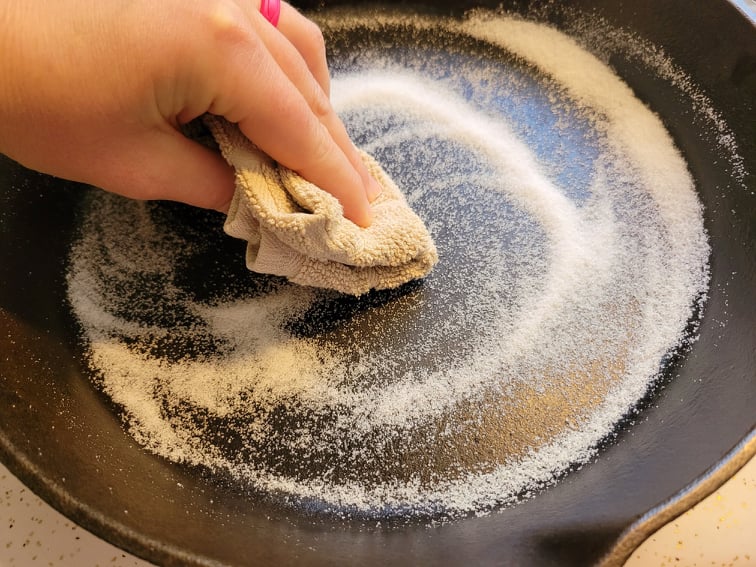
2. Wash and dry the pan thoroughly
Use dish soap and water to wash the pan, removing any residual flaky residue. Rinse the pan in cold water to help prevent flash rust from forming on the bare metal. Dry the pan well with a towel.
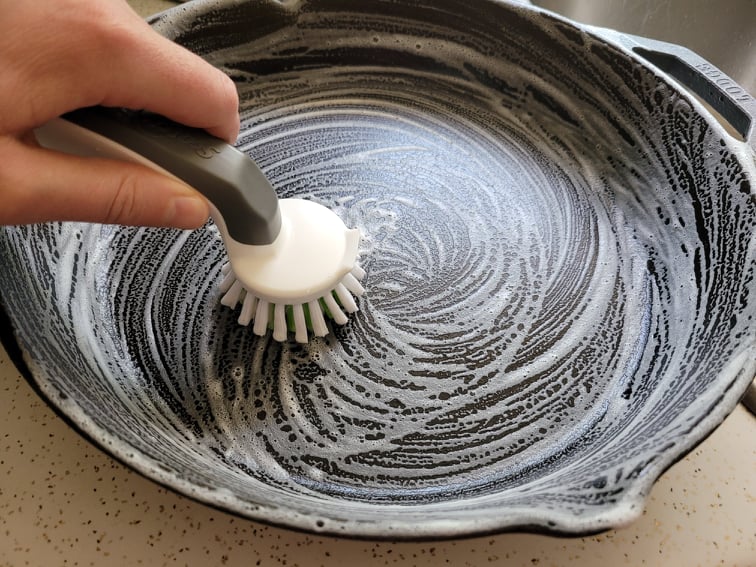
3. Season the pan
Pre-heat the oven to 450 degrees F. Use a lint-free cloth to rub cooking oil over all surfaces of the cast iron pan. I recommend using grapeseed oil, canola oil, or BuzzyWaxx for seasoning. Once the oil has been applied, take another clean, lint-free cloth and buff all surfaces of the pan to remove excess oil. You want to wipe it off really well, as if you’re trying to remove all the oil you just applied. There will still be plenty of oil in the tiny pores of the iron to produce a good seasoning layer without excess oil causing streaking, stickiness, and flaking.
Place your oiled pan upside down on the middle oven rack and heat it for an hour. When the hour is up, turn off the oven but don’t take the cast iron out right away. Crack the oven door open a few inches and let the pan gradually cool off until it is safe to handle. Repeat the oiling and heating process an additional two to three times to build up a strong seasoning layer that resists flaking and peeling.
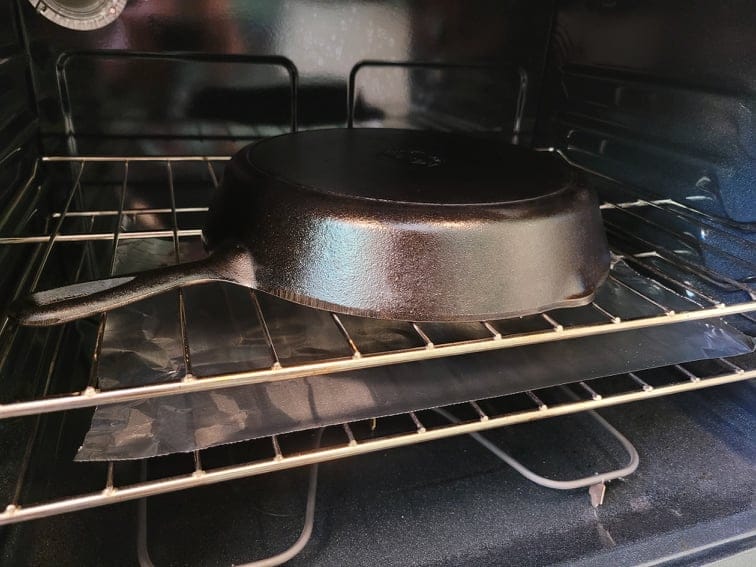
Summary
In summary, a strong seasoning layer is your best defense against flaking or peeling cast iron cookware. Don’t settle for the thin layer of pre-seasoning applied by the factory. I always recommend seasoning your pan an additional one or two times before cooking with it. But, things happen and sometimes your skillet may flake a little despite good care. Simply scour, wash, and re-season, and you’ll be back to cooking delicious cast iron meals in no time!
This post may contain affiliate links. This means if you click on a link and make a purchase, I will receive a small commission, at no cost to you, that makes it possible for me to keep the Campfires and Cast Iron site up and running. Please see our disclosure policy for details.

